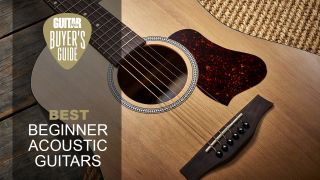Buying your first acoustic guitar is a fantastic moment and one you won't ever forget. That's why it's critical to do your research to ensure you get the right instrument for your needs. Luckily, you've come to the right place. We've designed this guide to the best acoustic guitars for beginners to help set you on the right path with your guitar playing and assist you in getting the ideal instrument in your hands.
Armed with an exemplary acoustic guitar, you'll be unstoppable. Not only will you find playing far easier and much more enjoyable, but if you have a guitar you love, you'll be more likely to stick with it and develop your technique. But what are the most important factors to consider when choosing the best beginner acoustic guitar for you? Well, you'll want a guitar that stays in tune throughout your practice sessions and it will need to be built to last as well.
Of course, ticking all these boxes shouldn't exceed your beginner budget, either. That'#s why, with this expert round-up of the best beginner acoustic guitars, we're committed to proving you can get started with a great guitar bearing the moniker of a big-name brand on the headstock from as little as $149.
We've rounded up and tested 10 of the best acoustic guitars for beginners and provided comprehensive buying advice to help you make the right decision. If you just want to get straight to our top recommendations, you can check out a couple of our top choices below.
Best acoustic guitars for beginners: Our top picks
For us, our top pick for the best beginner acoustic guitar has to be the Fender CD-60S. This acoustic delivers everything you could possibly need when starting out, and all at a delicious entry-level price. Offering newbies a great sound, flawless playability and rugged construction, it's just an absolutely stunning guitar for the money.
At the other end of the budget spectrum, the Martin LX1e is an ace option for those with a slightly larger budget. It delivers a versatile range of tones that really shine, whether you’re playing unplugged or using the built-in acoustic guitar pickup.
While it's not the cheapest beginner acoustic on this list, the Yamaha will remain a reliable companion beyond your years as a complete beginner, making it a great option for those who are thinking long-term!
Best acoustic guitars for beginners: Product guide

With this Fender, you have a leading brand producing an excellent acoustic guitar at an entry-level price. In our tests we found that this dreadnought’s all-mahogany construction produced a full, rounded sound, which equates to volume and confident mid-level power in support of a bright treble.
The tuners are positive and reliable, and at the sub-$200 mark they represent excellent quality compared with other guitars in this bracket. Previously, Fender’s acoustic guitars for beginners had an action that tended to be on the high side. But the CD-60S has an action low enough to enable easier playing, while avoiding troublesome fret buzz.
Read the full Fender CD-60S All-Mahogany review
- Explore today's best Fender CD-60S deals

Played by the Rolling Stones, no less, and with a lavish appearance created by that pearl inlayed neck and artworked scratchplate, Epiphone’s Hummingbird Pro certainly looks the part and has a reputation to match.
Based on its big brother from parent company Gibson, the ‘real’ Hummingbird would set you back closer to $3,000, so this one is a bargain. We found the sound to be well balanced and ideal for various styles, though the action, straight from the box, could be slightly lower to make it easier for beginner’s to play.
For electrified sessions, Epiphone’s built-in Eperformer preamp is versatile enough to dish out a wide range of tones. Elsewhere, for us, the Grover tuners maintained reliable tension.
Read our full Epiphone Hummingbird Studio review

One of the lower priced guitars in our guide, Yamaha’s FG800 is a seasoned veteran in the beginner’s acoustic field. The sound generated by this beauty could easily come from a more expensive guitar, and in use it’s reliable at holding its tune, too.
A solid spruce top, more usually found on higher priced guitars, helps create the impressive tone. And it we think it really is the sound that helps this guitar stand out from the others at the sub-$200 mark. No amplification is included, but for this price who’s complaining?
While the neck has a rounded, comfortable profile, we found the the action to be a little on the high side, though nothing a local guitar tech couldn’t remedy.
Read our full Yamaha FG800 review

Taylor’s GS Mini doubles as a travel-sized guitar and dishes out all you need for home playing, especially for younger or smaller guitarists. The factory-set action is low, making it simple to play from the get-go.
We found the sound to be warm and clear, tending towards the mid-range. Though the trebles are bright, despite the size the bass isn’t lacking. The sound also includes ample sustain with notes enduring longer than would be expected from a ‘mini’.
The broad tonal capability across the range makes it well suited to a variety of musical styles, meaning this is one of the best acoustic guitar for beginners if you’re searching for tonal versatility as well as for an entry-level guitar that could last far beyond your newcomer years – not to mention it's also a brilliant guitar for kids!
Read our full Taylor GS Mini Mahogany review

While the cutaway, giving access to the highest frets, is a noticeable standout in this guitar, the mahogany finish is also noteworthy. The neck is mahogany with a satin finish, which helps all of you beginner acoustic guitarists to play easier. That said, the action is on the high side.
Ibanez’s best acoustic guitar for beginners delivers a balanced, rounded tone thanks to the mahogany, and like many of the entry-level guitars in our guide it’s enough to keep more experienced acoustic guitarists happy.
The Ibanez AW54 also comes with an Ibanez preamp and Fishman pickup, plus a dual band equalizer. The sound through an amp matches the quality of the unplugged tone.

Martin has a reputation for crafting some of the finest acoustic guitars in the world, and we found the LX1E Little Martin to be no different: it’s a beautifully made instrument. It’s also a travel guitar, which makes it the best acoustic guitar for beginners seeking a compact strummer.
Don’t let the size fool you, though. Along with a brightness, in our test the guitar provided surprising volume from the Sitka spruce top and mahogany laminate sides. The high pressure laminate also helps deal with heat and humidity changes, which is useful for frequent travel.
Fishman Sonitone electric controls enable a relatively broad range of volume and tonal variety with a phase control to emphasize bass, which is useful when playing at lower volumes.
Read our full Martin LX1E Little Martin review

It may be considered a cheap acoustic guitar, but we found it difficult to find much wrong with the DR-100 for those on a budget. The Epiphone DR-100 produces a tone that you wouldn’t expect given the small price tag. Available in a variety of finishes, the build quality outmatches most of the competition in this price bracket.
A select spruce top is accompanied by a mahogany body and neck, the latter of which features a slim taper profile for more comfortable playing, finished off with a rosewood fingerboard.
In use it’s a relatively easy player, and the body has ample resonance. If you’re on a very small budget, the Epiphone DR-100 is a no-brainer.
Read the full Epiphone DR-100 review

Canadian made Seagull guitars are renowned for their high build quality, and the S6 is no different. It’s a grown up guitar in the sense that it’s far from flashy, but it has all you need to last beyond your beginner days.
Its refined construction is complemented with a bright tone but, especially useful for the more gentle fingerpicking style, the Seagull S6 enables beautiful warmth with a low volume and light touch. As you’d expect from this level of build quality, this beginner’s acoustic stays in tune and is so easy and enjoyable to play.

At around the $270 mark, the Alvarez AD30 is another dreadnought delivering well above its diminutive price tag. It kicks out significant volume from its sitka spruce body, which is as warm in tone as much as it is bright.
Playing can be subtle but also as aggressive as you want to get, and this is where the AD30 delivers a surprising amount of power. The X bracing design is intended to aid resonance, which certainly rings out.
Construction is rugged and the guitar stays reliably in tune. The 50/50 gloss to matt finish on the neck balances resilience with ease of playing. Conventional rather than flashy, the AD30 is a reliable allrounder.
Read our full Alvarez AD30 review
Best acoustic guitar for beginners: Buying advice

Choosing the best beginner acoustic guitar for you
You can trust Guitar World Our expert reviewers spend hours testing and comparing guitar products so you can choose the best for you. Find out more about how we test.
So, if you're reading this guide it's likely you're looking for one of the best beginner acoustic guitars for you or someone you know? Here's everything you need to know to ensure you make the right choice.
If you want to take an even closer look at some of the best acoustic guitars for beginners in this guide, we recently performed a group test on the Epiphone DR-100, Fender CD-60S and Yamaha FG800 which should help you zero in on the right guitar for you.
Acoustic guitar size, shape and sound
The first consideration you’ll need to make is the type of beginner acoustic guitar you're looking for, which will be primarily based on size and sound.

- Take your first guitar lesson
- 10 easy guitar songs
- How to play scales
Smaller-bodied acoustics are easier to play, and the size makes them more portable. By contrast, the larger the guitar’s body, the louder the volume and the bigger the tone it will produce. The most common acoustic guitar design, and the most versatile, is the dreadnought, which strikes the ideal balance between sound and playability.
At the opposite end of the scale is the jumbo acoustic, which produces greater volume, and the parlour guitar, with its small body and softer tone. Smaller still are mini or baby acoustics.
You’ll find a mix of the above in our best beginner acoustic guitars guide, and of the three main designs there are various spin-off styles too. Tried and tested brands in this area include Fender, Epiphone and Yamaha, and Taylor and Martin are notable brands at the more premium end.
Are beginner acoustic guitars easy to play?

Relatively speaking, beginner guitars should be easy to play. If the guitar itself makes progress more difficult than it needs to be, you’re less likely to want to pick it up and practice. That means looking for a low action – the height at which the acoustic guitar strings are set above the fretboard.
While aiding comfort, a smaller-bodied guitar is also easier to play, especially for younger players or smaller guitarists.
While the body of a dreadnought guitar typically joins the neck at the 14th fret, providing easier access to the higher notes, the parlour guitar typically has a join lower down at the 12th. If playing the highest notes is important to the music you want to play, you may also want to consider choosing a beginner’s acoustic guitar with a body cutaway below the neck.
How much should you spend on a beginner acoustic?
Once you've worked out exactly what you need from your beginner acoustic you can start to figure out your budget. We'd certainly suggest you avoid the sub $100, non-branded options you'll find on sites like Amazon. You'll quickly outgrow them and you'll run into issues like poor tuning stability, less than ideal action and poor sound.
As the guitars in this guide prove - we're looking at you Epiphone DR-100 - you can get your hands on a seriously well-equipped beginner acoustic for around $150. In fact, set a budget of between $150 and $250 and you'll walk away with a guitar that you will happily play for a few years without needing to upgrade.
Up your budget a little further and you can expect better components, improved tone and you may even get electronics as part of the package.

How do you tune a beginner acoustic guitar?
Tuning is typically a challenge for beginners, so guitar tuners, which ease the process and retain correct tension, are a vital accessory. If your budget is tight there are plenty of great clip-on guitar tuners on the market too. These are small, relatively inexpensive and easy to use.
If you get really stuck, we've compiled this handy step-by-step guide showing you how to tune a guitar.
Does my beginner acoustic need a pickup?
If the guitar you choose doesn’t include built-in amplification, a simple-to-install acoustic pickup can be retrofitted. You'll find examples of a variety of these types of strummers in our selection of the best acoustic guitars for beginners.
Buying advice: 30-second summary
Take a bitesize look at what you should consider before you buy one of the best acoustic guitars beginners:
- Think about guitar size: do you need a baby acoustic, small-bodied acoustic, dreadnought or jumbo?
- Are you buying a trusted brand? Fender, Epiphone, Yamaha and Taylor are great places to start.
- A low action – the height of the strings above the fretboard – makes a beginner acoustic guitar easier and more comfortable to play.
- Want to play higher notes? You'll need a guitar with a cutaway in order to access the higher frets.
- A guitar tuner makes a wise investment to keep your guitar sounding good.
- Want to amplify your playing? You’ll need to retrofit an acoustic guitar pickup, or opt for an acoustic electric guitar that comes already fitted with electronics
Where is the best place to get beginner guitar lessons?
Picking up one of the best beginner acoustic guitars is no use unless you know how to play at least the basics on it. Some people are able to pick things up by ear, or are lucky enough to have someone in the house to show them the ropes. If neither of these apply, we would always recommend taking lessons if you're able.
Face to face lessons are a great way to build a bond with a teacher and develop your skills in a hands-on way, but if you want to quickly understand basic guitar techniques, learn from the comfort of your home and don't have a huge budget, online lessons are a great, affordable route to take. You can learn more and discover our favorites in this guide to the best online guitar lessons.
You can currently make savings on a some of those platforms using the codes below, too.

How we test beginner acoustic guitars
When it comes to acoustic guitars, every player has their own personal preferences regarding the tone and feel. That said, regardless of taste, there are a few key criteria that a beginner acoustic guitar must meet before we'd feel comfortable recommending it.
Like with all instruments, we first look at the overall build quality. We closely inspect every inch of the guitar, from the body and neck to the machine heads, bridge, and saddle, to ensure they feel robust, sturdy and up for taking you on your musical journey.
We'll next check the consistency of the fretwork to confirm there aren't any sharp frets or uneven frets that may result in buzzing. This ties into the playability of the guitar. For us, the guitar should be comfortable to someone new to the instrument, and this means a reasonably forgiving neck and unobtrusive body.
Lastly, we move our attention to the sound of the acoustic guitar. To test the tone of the instrument, we will try a variety of different playing techniques and styles to see how the guitar handles them, from strumming wide-open chords with a flat pick to soft fingerpicking and everything in between. We are carefully listening to the volume the guitar produces and the overall tonal balance of the sound.
Find out more about how we make our recommendations and how we test each of the products in our buyer's guides.
More great beginner guitar gear guides
- Best beginner guitars: great acoustic and electric options
- On a budget? These are the best acoustic guitars under $500
- Just starting out? Check out the best beginner classical guitars
- Best ukuleles: acoustic and electric ukes for every budget
- Downsize to one of the best 3/4 acoustic guitars
- Best guitar picks: find the right plectrums for you
- The best guitar straps for boosting playing comfort
- Transform your tone with the best acoustic guitar pedals
- Plug in with the best beginner electric guitars
- Gear up with these guitar accessories for beginners





